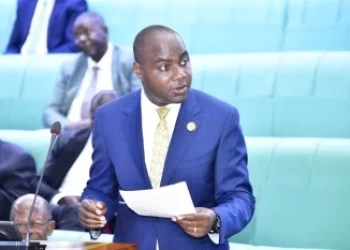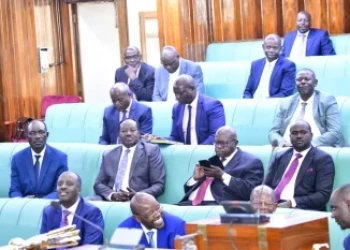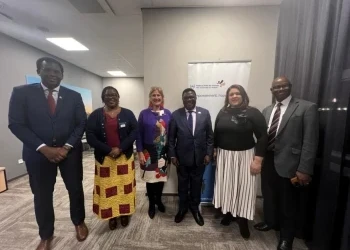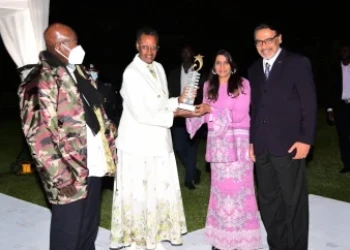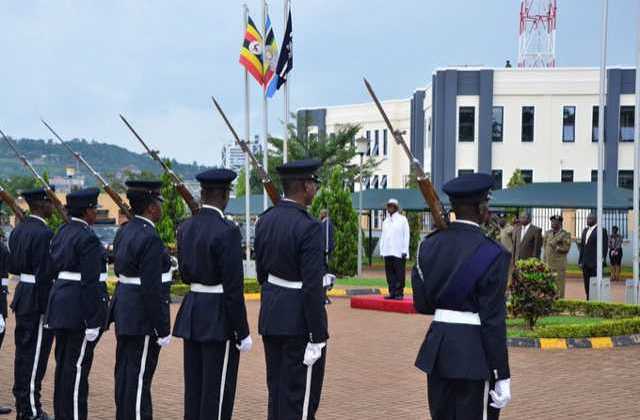
In delivering on the mandate and commitments set out in the National Resistance Movement (NRM) manifesto, the Internal Affairs ministry is comprised of various autonomous and semiautonomous institutions whose functions complement each other.
These institutions are:
1. Ministry of Internal Affairs
(MoIA) headquarters;
2. Uganda Police Force (UPF)
3. Uganda Prisons Service (UPS)
4. Directorate of Citizenship and Immigration Control
5. National Identification and Registration Authority; and
6. Directorate of Government Analytical Laboratories (DGAL).
UGANDA POLICE FORCE (UPF)
During the period under review, the Ministry of Internal Affairs, under UPF, committed to:
i. Increase Police staff strength from an original 44,601 personnel to fight crime and maintain law and order.
ii. Build capacity of UPF through professional staff development
iii. Invest in Information and Communications Technology (installation of CCTV cameras to fight crime
iv. Improve road safety
UPF INSTITUTIONAL DEVELOPMENT
The UPF now has staff strength of 47,775 officers, with the new 5,000 recruits who are undertaking training at the Police Training School, Kabalye
It conducted specialised and career development courses for over 10,000 personnel in various
disciplines, including executive leadership, strategic command and leadership programmes, noncommissioned officers course, advanced trainings in criminal investigations, forensics, canine, marine, fire, field force unit, counter terror, medical and air wing
Established a Police command and staff college at Bwebajja on Entebbe Road for continued professional staff development.
UPF fleet has increased from 7,410 to 9,226 (1,228 general purpose vehicles, 186 specialised vehicles, 19 construction equipment, 7,736 motorcycles, 53 marine vessels three helicopters and 01 fixed wing aircraft).
Intensified road traffic operations throughout the country, such as Fika Salama, use of speed guns and breathalyser, operation against drink driving and errant boda bodas to curb on road indiscipline
Launched the Express Penalty Scheme in collaboration with the Uganda Revenue Authority (URA)
and the works ministry to reduce on defaulting and eliminate fake driving permits
Established a garment factory that provides uniforms for Police staff.
Fully established the Police Exodus Savings and Credit Co- Operative Society and Duty free shop for members to be granted simple loans for individual development.
Benefited from government programmes, such as the National Agriculture Advisory Services (NAADS), Operation Wealth Creation, to establish family projects for police spouses to improve family income through growing vegetables, rearing goats and chickens in the various Police barracks.
The result of the above interventions has led to the following:
i. The Police to population ratio has improved from 1:941 to 1:845.
ii. Increased police presence in the country (Police presence in every sub-county countrywide.
iii. Reduced case workload per Police detective from 57.5 (2015) to 50.2 (2019).
iv. Improved public trust in the UPF.
v. Improved compliance to road traffic regulations by citizens
420 staff housing units at Naguru are nearly complete andplastering of walls and fixtures being done.
Constructed 25 Police staff houses at Kole, Ngora, Sironko, Bulambuli and Budaka.
Constructed 24 Police stations in Kabale, Nakaseke, Mitooma, Ibanda, Isingiro, Kyenjojo, Kyotera, Bududa, Paidha,Pakwach, Nwoya, Rubirizi, Wakiso, Kayunga, Luuka, Namutumba, Serere, Sironko, Omoro, Budaka, Lyantonde, Natete, Kiruhura and Mityana;
Completed a motor vehicle maintenance centre in Namanve and now expanding to Soroti and Mbarara regional workshops;
Constructed an aviation maintenance base at Jinja District.
Constructed a 20-bed maternity ward in Mbale.
Established a specialised diagnostic centre at Kololo, with the superstructure roofed.
Completed Tororo Police Health Centre III.
Renovated Arua Police health centre III.
Completed Phase I installation of CCTV cameras in the Kampala Metropolitan Area in which 3,101 cameras were installed.
Commenced Phase II of the CCTV project upcountry in major towns and municipalities of Lugazi, Kayunga, Njeru, Iganga, Masaka, Gulu and Jinja.
A total of 67,321 firearms have been test fired, 13,313 cartridges captured with Uganda Police Force representing 84% of the registered firearms in the country.
A ballistic database of fingerprinted firearms has been established.
Commissioned the CCTV National Command Centre at Naguru, whose network is linked to 18 divisional centres and 83 Police stations. CCTV monitoring centre was established at Nateete Police Station.
Acquired an Automated Fingerprint Information System (AFIS), Criminal Databases, including a Criminal Automated Biometric Identification System (CABIS) and other assorted DNA equipment to assist in the criminal investigations.
Established an ICT Research and Innovation centre in Kikandwa for in-house development of applications.
UGANDA PRISONS SERVICE
During the period, the Ministry of Internal Affairs, through UPS, committed to:
1. Increase cotton and maize production
2. Build a mini-max security
prison at Kitalya to accommodate
2,000 inmates (7,200 sq metres)
3. Construct 5 low-cost prisons
4. Relocate Kigo Prisons
5. Build accommodation for Prisons Service staff
UGANDA PRISONS SERVICE (UPS) – INSTITUTIONAL DEVELOPMENT
Recruited and trained 5,024 warders & wardresses, 197 Cadet
Principal Officers and 213 Cadet ASPs.
Strengthened the Prisons SACCOS and increased membership from 6,874 to 9,569 members, representing 81.6% of staff with an asset base of sh6.8b.
Piloted irrigation scheme at Bulaula Prison farm to mitigate effects of drought on 150 acres. The scheme has now been rolled out at Bugungu Young Prisoners’ Farm.
Continues to produce furniture for Ministries, Departments and Agencies as per the Presidential Directive.
Established a Timber Drying Kiln in a bid to support Government policy on BUBU.
In support to local textile industry needs; a total of 6,027 bales of cotton produced between FY 2016/17 and FY 2018/19.
Average of 775 MT of quality maize seeds (OPV, hybrid, and foundation seed) produced and processed annually – Germination Rate of 94%.
Average of 6,516 metric tonnes of maize grain (valued at sh6.52b) produced annually to support prisoner feeding.
Acquired 36 tractors, one combine harvester, one bull dozer and one grain dryer to mechanise farming practices on Prisons farms.
As a result of the above interventions, the ministry has been able to realise:
i. Reduced escape rate from 13.9 to 5.9 per 1,000 prisoners held in custody.
ii. Improved welfare of Prison staff and their families.
iii. Improved the staff to prisoner ratio to 1:7.
iv. Increased productivity of prisons farms.
Completed construction of a 2,000 prisoners’ capacity Mini- Max security prison at Kitalya;
Construction of 10 low-cost prisons completed in the following areas Orom-Tikau, Nebbi, Adjumani, Amita, Mutukula, Ruimi, Sheema, Kyenjojo, Nwoya, & Mutuufu.
Constructed 1,467 low-cost staff housing units: Also, construction of 220 staff housing units with sanitation facilities at Kitalya, Ragem, Amita, Mukuju and Bulaula is nearing completion.
A total of 182 prisons staff have been enabled to construct their homes through the Prisons Duty Free Shop; A total of 2,204 staff have benefited since inception.
134 CCTV cameras installed at Luzira Prisons main gate, upper prison and the main prisons of Gulu Masaka, Nakasongola, Jinja, and Mbarara.
As a result of the above interventions, the ministry has been able to realise:
i. Reduced congestion of prisoners.
ii. 42% of prisons staff are now housed.
iii. Enhanced supervision of prisoners.
DIRECTORATE OF CITIZENSHIP AND IMMIGRATION CONTROL (DCIC)
The ministry, under DCIC committed, to:
i. Leverage the use of ICT for management of immigration services.
ii. Ensure ease of access to dual citizenship for Ugandan diaspora community.
INSTITUTIONAL ACHIEVEMENTS;
EAC e-Passports have been operationalised.
It is an online application — www.passports.go.ug
Passport application, processing, enrolment and issuance have been fully computerised.
Fully implemented the e-immigration system, which has facilitated the electronic issuance of visas, permits and passes.
Personalisation services of visas can now be accessed at Uganda’s 17 missions.
Established an automated Border Control Management System under the e-immigration system.
Installed electronic-gates at Entebbe International Airport for faster clearance of travellers.
The automated border management system is capable of tracking entry and stay of persons in the country.
Integrated the e-immigration systems (including the e-passport system) to the URA e-payment system for a streamlined Non-Tax Revenue (NTR) collection from immigration facilities.
Integrated the e-passport system to the National Identification Register (NIR) to facilitate citizenship verification and streamline the issuance of passports to Uganda citizens.
The electronic-immigration system (www.visas.immigration.go.ug) was upgraded to include
online citizenship application, processing and management. Ugandans in Diaspora can now
apply online and acquire dual citizenship.
i. Deployed Immigration Attaches in six Ugandan foreign missions, including Washington DC, Ottawa,
London, Copenhagen, Abu Dhabi and Pretoria to co-ordinate and facilitate the management of dual citizenship, among other immigration services
Increased the number of gazetted border posts from 42 points to 53 border points, hence providing more routes for traders to access the market.
Increased the number of borders operating 24 hours a day from four to six in number
(Elegu, Malaba, Busia, Mutukula, Entebbe International Airport and Katuna) providing timely trade and clearance of goods from eight days in 2010 to two hours in 2020.
Operationalised the use of the National Identification cards as travel documents to enhance free movement of persons and goods.
Established an Immigration Training Academy at Nakasongola to build capacity of immigration
officers, impart knowledge and skills on the ever-changing trends of migration management.
As a result of the above achievements, the ministry has been able to realise:
i. Reduced lead-time for issuance of work permits from 30 days three years ago to seven days now.
ii. Reduced lead-time for passport issuance from 14 days 6 months ago to 4 days.
iii. Improved Non-Tax Revenue collections from UGX 165bn in FY 2015/16 to UGX 216bn in FY 2018/19.
iv. Ease of verification of citizenship for issuance of passports.
NATIONAL IDENTIFICATION AND REGISTRATION AUTHORITY
Institutional achievements;
i. To date a total of 25,372,971 persons are on the National Identification Register representing 62.5% of the total population of the country.
ii. 15,246,282 national identification cards have been issued representing 83% of the population eligible for national card issuance.
INSTITUTIONAL ACHIEVEMENTS
To date a total of 25,372,971 persons are on the National Identification Register representing 62.5% of the total population of the country.
15,246,282 National identification cards have been issued representing 83% of the population eligible for National Card issuance.
6,705,524 pupils and students were fully registered and assigned National Identification Numbers (NINS).
Integrated NIRA services with the following entities; URSB, DCIC, MoPS, URA, MoES, NSSF,
MoLHUD, UCC & EC.
The infrastructure for implementation of Third Party Interfaces (TPI) has been fully established and functional.
A total of 58,162,433 records were accessed (35,663,697-TPI & 22,498,736-Manually).
60 entities accessed the National Identification Register either through TPI or manually.
DIRECTORATE OF GOVERNMENT ANALYTICAL LABORATORY (DGAL)
DGAL is committed to:
i. Provide efficient and effective analytical services
ii. Train and certify scientist
iii. Establish the National DNA Database to fight crime
INSTITUTIONAL ACHIEVEMENTS
DGAL Acquired the following:
Liquid Chromatography Mass Spectrometer machine and A Gas Chromatograph Mass Spectrometer for testing poison
Genetic Analyser for DNA analysis,
Automated Ballistics Information System for ballistics and gun analysis,
Video Spectral Comparator 8000 equipment for Questioned Document analysis and
Bullet Recovery System to assist in the forensic investigations.
Inspite of the challenges the Ministry has faced during the implementation of the NRM Manifesto 2016-2021, we have been able to attain 80% of our targeted interventions. The ability of the sector to attain the key priorities as reflected in the presentation has largely depended on the availability of adequate resoiurces.
Comments (0)
📌 By commenting, you agree to follow these rules. Let’s keep HowweBiz a safe and vibrant place for music lovers!


